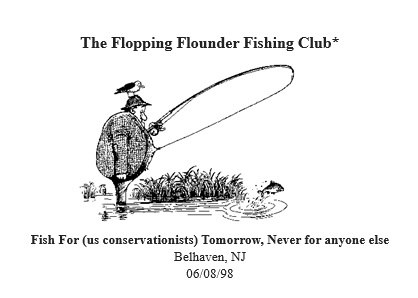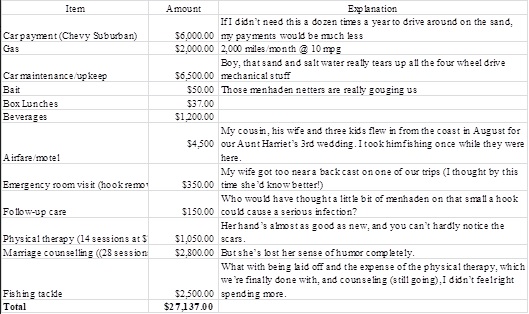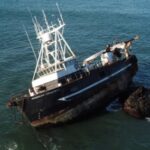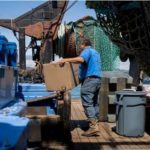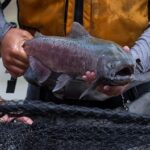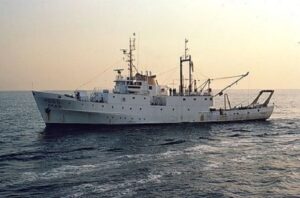Looking Back at FishNet USA – “New Conservationists” and the Flopping Flounder Fishing Club
In these days of seemingly unrelenting grim news I thought I’d try to lighten the atmosphere somewhat by sharing with you what I consider possibly entertaining piece I wrote and distributed twenty years ago. For those unfamiliar with Mid-Atlantic fisheries management, the striped bass (Morone saxatilis) fishery is managed by a per-state quota, and each states’ quota is divided into commercial and recreational components. Way back when the New Jersey Legislature passed a bill which made it illegal to sell striped bass so the commercial quota was added onto the recreational quota. The commercial was never – and still isn’t – very large, but the unfairness of the law and the fact that it on occasion it necessitates the over-the-side disposal of what would (should?) be perfectly saleable striped bass bycatch grates on a whole lot of commercial fishermen.
Accordingly back in 1998 the Garden State Seafood Association – which I was employed by at the time – persuaded two state legislators to introduce a bill that would have allowed 200,000 pounds of the annual commercial striped bass quota to be kept and sold by commercial fishermen. Not too surprisingly, the bill died in the legislature, reportedly generating a historical amount of constituent interest. But, to point out the unfairness of the NJ regulations, I created a Jersey recreational fisherman, Rocky Saxitilis (the “scientific” name of the striped bass is Roccus saxatilis), The Flopping Flounder Fishing Club, and the attached letter from him to the NJ Legislature.
I hope you enjoy it. And for those of you who are currently or who will be fighting allocation issues with other user groups, perhaps it will provide you with some inspiration as well.
Please stay safe and healthy,
Nils
——————————————————————–
The new conservationists
02/09/99
“Conservation” is the controlled use and systematic protection of natural resources
At the end of the 19th and into the early 20th centuries people of the stature of John Muir, Aldo Leopold and Henry Beston were redefining the word “conservation” and establishing a new, and at the time revolutionary, way of thinking about humankind and our relationship to the natural world. In reading Leopold’s A Sand County Almanac, Beston’s The Outermost House or in contemplating the thousands of square miles of wilderness that are an important part of our heritage thanks to Muir’s unique vision, it is impossible to imagine people with lives more in tune with the natural world.
Anyone recently involved in fisheries issues can’t help knowing that the torch they lit has supposedly been passed down to modern self-described “conservationists” who only a few years ago were just people whose hobby was catching fish or whose businesses involved catering to those hobbyists. Today these people, who we’ll call New Conservationists, band together in “conservation” organizations and actively – and sometimes successfully – pursue political agendas ostensibly based on the proud legacy of those men who created the conservation movement. But let’s take a look at how in tune these New Conservationists might be with the conservation ethic that Muir and Beston and Leopold so successfully established.
For a fictional journey into the psyche of a mythical New Conservationist, we refer you to Rocky Saxatalis’ letter on striped bass which is down below. Rocky’s attitude, which we have unfortunately found isn’t all that fictional, provides the basis for a coming FishNet that will explore New Economics, a discipline that appears to have arrived concurrently with New Conservation.
A note for the sensitive: Several people – we would assume New Conservationists – who stumbled upon this letter took such offense at it that they directed the attention of various elected officials and fisheries managers to it to share their outrage. Needless to say, for anyone so inclined we encourage such referrals. Probably as needlessly, if any of those who were referred to the letter shared any outrage, as yet we haven’t heard about it.
One of the easiest ways to recognize a New Conservationist is to identify the vehicle he or she is driving. The sport utility vehicle is the New Conservationist’s hands down favorite. The four wheel drive pickup truck is a close second. Whichever the choice, it will probably be festooned with racks to proudly display fishing poles and ice chests. If a vehicle weighs several thousands of pounds more than it has to, if it gets less than half the gas mileage that it could, if it has four wheel drive, big knobby tires with raised lettering, and a trailer hitch on the back, there’s a good chance there’s someone driving who thinks of himself as a conservationist. If the truck or SUV is parked in a garage, driveway or parking lot located on what used to be a salt marsh or other coastal wetland, the chances are even greater.
Where this sport utility vehicle or other vehicular behemoth is being driven is another indication of whether a New Conservationist is the owner. If it’s up and down the beach – something that would undoubtedly make Henry Beston throw up his hands in bewilderment but seems to be the primary activity of many of the New Conservationists – or to the closest marina or boat launching ramp, you can be almost totally assured that the driver and passengers are basking in the glow of the conservationist’s torch. And basking in multi-speakered, air conditioned comfort at ten or fifteen miles per gallon.
When reaching the marina or launching ramp, what is our boat-based New Conservationist most likely to do? Probably climb into a fiberglass craft that might well last until the next ice age, crank up the one or two – or more, if we can actually believe what we see in boating magazines – 100+ horsepower outboard motors, and go roaring off at 40 mph in pursuit of the “fish of the day,” leaving behind a remembrance of his passing in the form of a petrochemical slick on the water and a cloud of haze in the air. Meanwhile, back on the beach his land-based compatriot is cruising up and down the strand in his quest for fish, turning areas that were once the exclusive domain of sand pipers, piping plovers, frisbee tossers, sun bathers and nesting turtles into a slower-speed version of the freeways back home.
Up until now it might be somewhat difficult to understand how these supposed disciples of Muir, Beston and Leopold think they are carrying on the conservationist tradition. But, on the fishing grounds once they’ve caught and killed all the fish they want to take home to either eat or hang on the wall as “trophies,” they stop throwing their catch into their buckets or coolers and begin practicing what’s known as “catch and release.” Catch and release is a process involving hooking a fish, allowing it to struggle at the end of the line until exhausted enough to be reeled in, taking it off the hook and putting it back in the water, supposedly to live to “fight another day.” This is done until they’ve fully satisfied their urge to fish or the fish stop cooperating and is the primary way the New Conservationists think they conserve. (We must note here that catching and releasing isn’t inflicted only on the fish the anglers don’t want to eat or to hang on their walls. Fish are also caught and released because they are too large, too small, out of season or of the wrong species to be legally kept.)
“Over 75 per cent of small snapper caught during NSW Fisheries ‘angling trials’ survived in the long term.” (Fishing for the Future – Catch and Release Fishing Fishnote DF/27, W. Talbot, Technical Officer S. Battaglene, Biologist, Brackish Water Fish Culture Research Station, Port Stephens, New South Wales)
“Bait caught fish typically suffer a much higher hooking mortality than fish caught on flies and lures. At least 1 out of 3 fish caught with bait will die after release. Over 60% of deep hooked fish die….When fishing deep water (deeper than 30 feet) most fish caught cannot be released with any assurance that they will survive….Fish that are already stressed by warm water temperatures or low dissolved oxygen conditions cannot handle the added stress of being caught and most likely will not survive after being released.” (Utah Division of Wildlife Resources – Catch & release fishing information and techniques) Link to State of Utah Catch and Release page
“Catch-and-release ideologies aside, one camp maintains that the well-intended effort may serve scant purpose. The large specks (speckled sea trout) more than 25 or 26 inches long cannot handle the stress created by catch-and-release. Most die within days, even hours, of being turned free. Or, so the detractors claim….We’ve consistently had survival rates of 90 percent on ‘school trout’ caught on rod and reel and maintained for research purposes….The survival rate following catch-and-release of “trophy class” trout remains unconfirmed; however, the biologists do have opinions based on their work with coastal finfish. They conclude that, under proper circumstances, big trout have at least a 50 or 60 percent chance of survival.” (Joe Doggett – Saltwater Action column – Texas Fish and Game magazine) Link to Texas Fishing page
“PHYSIOLOGICALLY SPEAKING – According to Dr. Bob Reinert of the University of Georgia, the stress that fish exhibit after being caught is caused when hormones, known as catecholamines and corticosteroids, are generated in the fish’s body. They dramatically increase blood flow in the gills and muscles, imbalancing the fish’s blood electrolytes and building up lactic acid in the blood. If the blood becomes too acidic, osmotic shock can set in, rapidly killing the fish. Even if osmotic shock doesn’t kill the fish, its immune system can shut down from the stress, resulting in the fish’s death from disease days later.” (Bill Byrd – Catch and release that works – Fly Fish America) Link to Fly Fish America Catch and Release page
“BUT, IS CATCH AND RELEASE THE ONLY ANSWER? What about angling ethics? Is it ethical for a skilled angler to catch and release thirty, forty, fifty fish or more in a single day? I’ve done that myself and I’m not proud of it. Today, I know that delayed mortality probably resulted in the death of many of those fish. A dead fish is a wasted resource and perhaps the fish and we would be better off if we caught a limit of eaters and went home.” (Tony Dean – South Dakota Outdoors- Is It Time To Take Stock?) Link to South Dakota Walleye fishing page.
Unfortunately, many of the fish caught and released by New Conservationists – or by anyone else, for that matter – don’t live long enough to fight on that other day. Research indicates that a significant percentage of released fish don’t survive this kind of conservation, in short order becoming crab, shark or seagull food. While the New Conservationists consider any fish not remaining belly-up at release a healthy and happy survivor, this isn’t necessarily so. Delayed catch and release mortality, which can reach 20 or 25 percent, has real conservationists rightfully concerned.
Catching and releasing is one of two activities that distinguishes New Conservationists. The other, of course, is condemning commercial fishermen at every opportunity for catching and keeping – and providing to consumers – those same fish the New Conservationists want for themselves. Try as they might to cloak it in self-righteous rhetoric, the New Conservationist’s brand of “blame someone else, I’m not the problem” conservation is nothing like the real thing. But they’ve found that it’s too hard to look in the mirror – those big SUVs and fancy boats must be tremendously appealing to them – and easy to point a finger at the other guy. The first “other guy” is a commercial fisherman but behind him are millions of seafood consumers.
CONSERVATION QUESTION: Is it better to catch and keep two or three fish for personal consumption then go home and wax the SUV, or to catch and release twenty or more, knowing that a significant proportion aren’t going to “live to fight” another day?
Please Note: We know some recreational anglers who are as concerned with the “footprints” they themselves leave in the natural world as those that are left by others. True conservationists, they are environmentally aware and responsible and their lives reflect it. These comments aren’t directed at them. Their houses are in order and they aren’t built of glass.
_________________________
The Flopping Flounder Fishing Club*
Fish For (us conservationists) Tomorrow, Never for anyone else
Belhaven, NJ
06/08/98
Dear Senator (or Assemblyman or Assemblywoman) _______________:
I am writing to you about the Bill recently introduced by Assemblymen Asselta and Impreveduto that would let netters catch and just about anybody eat striped bass in New Jersey. I and all my buddies down at the Flopping Flounder Fishing Club oppose this. I know that the netters are saying that this is legislation for New Jersey consumers and doesn’t have much to do with fishing, but let me set the record straight. The netters are using this as a foot in the door. Today they want to be allowed to keep a small part of the commercial striped bass quota that the Atlantic States Marine Fisheries Commission has already allocated to them. Tomorrow they’ll want more, and we know those industrial, search and destroy, converted aircraft carrier and nuclear submarine, foreign owned factory trawler fleets that they’re in cahoots with are anchored just over the horizon, just waiting to get to our New Jersey stripers.
I’m a committed conservationist (I used to be a sportsfisherman, but if we don’t call ourselves that no one will think we kill as many fish as we do) and am a proud, card carrying member of the angling fraternity. We’ve shown time and again with real, scientific studies that we’ve paid good money for that we contribute more to New Jersey’s economy every year than just about anybody else. As proof, let me share with you my sportsfishing….oops, I mean my conservation expenditures for last year alone (I’ve been keeping careful records since I caught my first striper back in ‘91):
If you’d like to check any of these numbers, I’ll be glad to put you in touch with my Chevy dealer and his mechanic (if you want to know how important fishin….er, conservation is to the economy, ask them how they’d like me to go back to driving a four cylinder, 32 mpg Saturn), our marriage counselor, the physical therapist or my bait shop.
And last year, because there wasn’t any striped bass catching – or eating – allowed in New Jersey for anyone but us sportsfis….darn, sorry again, conservationists, I caught 14 keepers that totaled 87 pounds. That’s almost $300 a pound – and I didn’t even count the cost of the Boeing 747 that Vinnie and his family flew in on or that fine for the Piping Plover nesting incident down there on the beach. (I’ve gotta be honest here and tell you that my beverage expenditures this year won’t be anywhere near as much. Since the accident, the only way my wife will get into the Suburban is if she checks the coolers and the only thing she sees is Diet Coke.)
The netters want 200,000 pounds of our striped bass. At the $300 I’ve shown you we spend on every pound of stripers we catch, giving them those fish will cost the New Jersey economy $60 million dollars – just because they weren’t caught and eaten by us conservationists (nailed it that time!). All they’ll do is sell those fish to restaurants and fish stores where just about anybody could eat them. Is that right? I mean, whose ocean is it, anyway?
The way me and the guys at the Flopping Flounder feel, these are our striped bass and no one else’s. Just the other night we sat down and figured out that in the last ten years we spent a total of 43 years fishing for other species, just to give the stripers a chance to come back. Believe me, you’re talking serious sacrifice here. Did you ever have to catch a bluefish when what you really wanted was to sink your hooks – then your teeth – into a striper? No joke, we actually did that more than once. Those seven million plus citizens of New Jersey who can’t be bothered or can’t afford to catch them for themselves have gotten along without our striped bass for years and probably most of them don’t even miss them anymore. Besides, the restaurants and seafood markets can always sell those farmed striped bass/perch hybrid things – they’re almost as good, I’ve been told (of course, I don’t know that for sure because me and the other Flopping Flounders are among the few people who’re allowed to eat real striped bass fresh out of the water here in New Jersey – and, right or wrong, we’re going to do whatever we have to do and say whatever we have to say to keep it that way!)
Remember, netters are only killing fish for food, but every fish us conservationists kill might have been a trophy!It’s about time you guys in Trenton got your priorities right. Are you there to represent everybody in New Jersey, those seven and a half million people who don’t know one end of a fishing pole from another, or are you there to represent us sportsf…er, conservationists and to make sure that no one else ever gets to eat one of our striped bass? There aren’t a lot of us conservationists (bingo…twice in one day!), but we sure can yell loud – and when’s the last time you saw someone yelling at a waiter in a New Jersey restaurant because he couldn’t eat one of our stripers? Down at the Flopping Flounder we say anybody that feels that way can go to a restaurant in some other state.
Let them eat cake – or orange roughy,
“Rocky” Saxatalis
Sergeant at Arms
The Flopping Flounders
p.s. If you and your buddies over there in Trenton do the right thing and shoot this Bill down, us Flopping Flounders will be glad to send an ocean-fresh striper in your direction. It’ll make a meal you’ll never forget – and if we get our way it’ll be the only one you’ll ever legally taste in New Jersey unless you catch it yourself.
* Note: This fictional letter was created to emphasize – through exaggeration – how unsupportable we feel some of the arguments are that are being used to justify a continued ban on the consumption of striped bass by New Jersey’s non-fishing citizens. There is no Flopping Flounder Fishing Club, “Rocky” Saxatalis is not a real person, his wife has neither a scarred hand nor physical therapy bills, and some Chevy Suburbans might get more than 10 mpg. Our intention wasn’t – and still isn’t – to offend the many responsible recreational fishermen who are committed to a future with healthy fisheries. For those who truly find our attempt at humor offensive, we offer our most sincere sympathy. “Never say a humorous thing to a man who does not possess humour. He will always use it in evidence against you.” (Sir Herbert Beerbohm Tree).







